M3教案
外研八上教案M3 Sports U3

Unit 1 In China, we open a gift later.教学目标【知识目标】1、能够正确使用以下单词和词组:cap, chopstick, toy, video game, gift, surprise, immediately, difference, accept, tradition, example, for example, must, month, serious, taste2、能够正确使用must, mustn’t, can, can’t, need, needn’t。
【能力目标】1、能够听懂某地的风俗习惯或社会行为。
2、能够谈论某地的风俗习惯或生活习惯。
【情感态度目标】了解中西方文化差异,尊重他国文化,更好地理解英语语言。
教学重难点【教学重点】能够听懂某地的风俗习惯或社会行为。
【教学难点】能够谈论某地的风俗习惯或生活习惯。
教学过程Step1 Warming-upT: From the title, you can know we will talk about a gift. Because Lingling’s birthday is coming, some of her friends are talking about what gift to buy for her. First, let’s see what they are. Step 2 PresentationT: OK, You have known what presents they are. Now, let’s listen to the tape. You have two tasks: first, number the words and expressions as you hear them,and then find out what present they want to buy for Lingling.Step 3 Listening1.T: Lingling’s friends are celebrating Lingling’s birthday at her home. Let’s listen what they aretalking about and answer the questions:1)Does Lingling open her present later or immediately?2)What kind of other traditions are they talking about?2.T: Listen again and check what you usually do in China.1) Open a present immediately when you receive it.2) Accept a present with both hands.3) Use red paper for hongbao.4) Do cleaning on the first day of the Spring Festival.5〕Cut your hair during the Spring Festival.6〕Break something during the Spring Festival.Step 4 ReadAsk the students to read the dialogue by themselves first. Then work in pairs. Finally the teacher will choose the lucky number to read the dialogue correctly, loudly and beautifully.Step 5 Practise1. Fill in the tableT: After reading the dialogue several times, please try your best to fill in the table. If necessary, youIn China, when someone gives you a gift, you must ________ and _________. But in the US, you needn’t ______or ________.On Spring Festival, Chinese people must ________ and mustn’t _____. And they had better________________.T: Open your books and turn to page 89. Please do Activity 4Step 7 SummaryT: Let’s look at the blackboard. Who can tell us what we have learnt today.课堂作业Review:Oral: A. Read the dialogue correctly, fluently and beautifully.B. Make up a new dialogue according to what you have learnt today. (Talk aboutmid-autumn day or something else)Preview:Read the passage in Unit 2 and know what it’s about. 教学反思。
外研社版英语(新标准)(一年级起点)六年级上册M3教案教学设计

(一)语言知识目标:全体学生能理解运用句型Have you got…?及单词book.部分学生能运用:collect, stamp。
(二)语言技能目标:能听懂会说目标语句,能运用它们进行问答。
(三)情感态度目标:通过欣赏各国家邮票培养美的感受。
(四)学习策略目标:积极运用联想,在词语和相应事物之间建立联想。
此活动是安排在听、说、读之后的用,活动的设计遵循了层次性、梯度性原则。
(六)总结和作业(3分钟)
1、总结
What have you learnt this class?
2、布置作业
必做:
1)听读课文。达到流利,发音正确,一颗星。(听、读作业)
2)练习背写单词:stamp, book, collect
1)Have you got any stamps from China, Simon?
Why?
2)Does Daming collect stamps?
3)Will Daming collect stamps?
6、听音跟读。
7、听、指、读。
第一遍听音整体感知了解大意,学习单词stamp并由stamp引出评价,通过评价拓展学生视野,了解世界各地的邮票。第二遍听音逐图学习,在语境中体会、理解课文。提取重点并板书。
3、写:全体学生能写出2-3个与本模块主题相关的语句。
(三)情感态度目标:
通过欣赏各国家邮票使学生感受美,体验美。
鼓励学生拥有自己的爱好,快乐地学习与生活。
(四)学习策略目标:
积极运用联想,在词语和相应事物之间建立联想。
(五)文化意识目标:
通过了解中西方邮票,进一步注意到中外文化异同。
三、教学重点及难点
外研社小学英语课件-M3复习教案
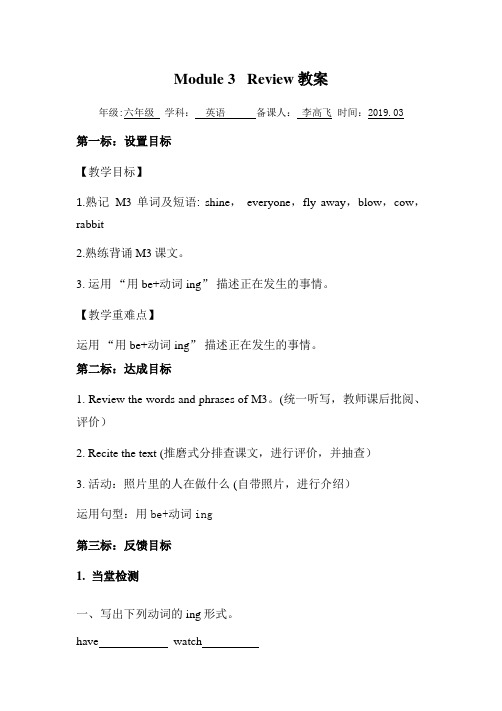
Module 3 Review教案年级:六年级学科:英语备课人:李高飞时间:2019.03第一标:设置目标【教学目标】1.熟记M3单词及短语:shine,everyone,fly away,blow,cow,rabbit2.熟练背诵M3课文。
3. 运用“用be+动词ing”描述正在发生的事情。
【教学重难点】运用“用be+动词ing”描述正在发生的事情。
第二标:达成目标1. Review the words and phrases of M3。
(统一听写,教师课后批阅、评价)2. Recite the text(推磨式分排查课文,进行评价,并抽查)3. 活动:照片里的人在做什么 (自带照片,进行介绍)运用句型:用be+动词ing第三标:反馈目标1.当堂检测一、写出下列动词的ing形式。
have watchtake startrain eatfly runsing jump二、将下列短语译成英语。
度过愉快的一天去公园开始下雨淘气的鸭子在树上(外来的)在树上(本身长的)三、将下列句子补充完整。
1.In this photo, the sun __________________(照耀着).2.The birds __________________ (正在唱歌).3.Now look at this photo. We are ____________________(野餐).4.The ducks __________________________________(正在吃我们的三明治).四、用be动词的适当形式填空。
1. It _____ going to rain soon .2. I ____ having a picnic with my friend .3. Sam ___ flying a kite in the park .4. They ____ sing a English song .5. ____ you cleaning your room?五、用括号内单词的正确形式填空。
新外研九上M3 Heroes教案
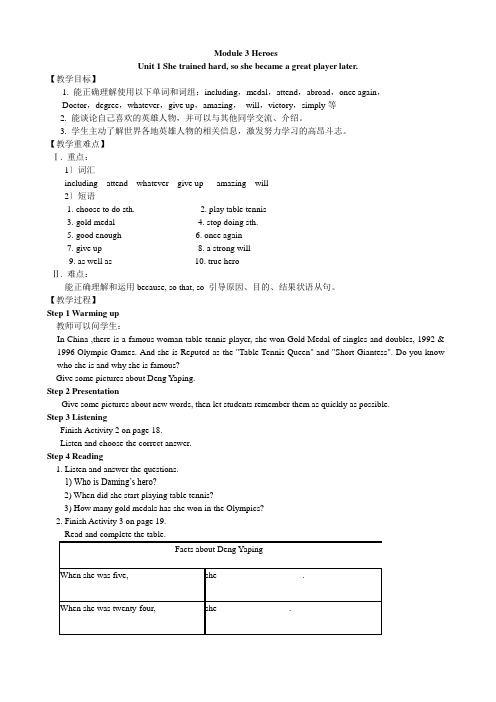
Module 3 HeroesUnit 1 She trained hard, so she became a great player later.【教学目标】1. 能正确理解使用以下单词和词组:including,medal,attend,abroad,once again,Doctor,degree,whatever,give up,amazing,will,victory,simply等2. 能谈论自己喜欢的英雄人物,并可以与其他同学交流、介绍。
3. 学生主动了解世界各地英雄人物的相关信息,激发努力学习的高昂斗志。
【教学重难点】Ⅰ. 重点:1〕词汇including attend whatever give up amazing will2〕短语1. choose to do sth.2. play table tennis3. gold medal4. stop doing sth.5. good enough6. once again7. give up 8. a strong will9. as well as 10. true heroⅡ. 难点:能正确理解和运用because, so that, so 引导原因、目的、结果状语从句。
【教学过程】Step 1 Warming up教师可以问学生:In China ,there is a famous woman table tennis player, she won Gold Medal of singles and doubles, 1992 & 1996 Olympic Games. And she is Reputed as the "Table Tennis Queen" and "Short Giantess". Do you know who she is and why she is famous?Give some pictures about Deng Yaping.Step 2 PresentationGive some pictures about new words, then let students remember them as quickly as possible.Step 3 ListeningFinish Activity 2 on page 18.Listen and choose the correct answer.Step 4 Reading1. Listen and answer the questions.1) Who is Daming’s hero?2) When did she start playing table tennis?3) How many gold medals has she won in the Olympics?2. Finish Activity 3 on page 19.3. Read the conversation again and finish Activity 4 on page 19. (学生独立完成后,小组内交流答案。
四年级上英语教案-M3 U2 What’s the elephant doing-外研社(三起)
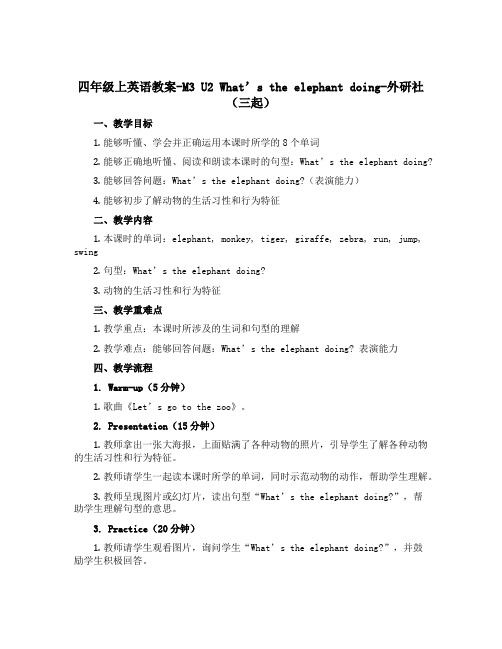
四年级上英语教案-M3 U2 What’s the elephant doing-外研社(三起)一、教学目标1.能够听懂、学会并正确运用本课时所学的8个单词2.能够正确地听懂、阅读和朗读本课时的句型:What’s the elephant doing?3.能够回答问题:What’s the elephant doing?(表演能力)4.能够初步了解动物的生活习性和行为特征二、教学内容1.本课时的单词:elephant, monkey, tiger, giraffe, zebra, run, jump, swing2.句型:What’s the elephant doing?3.动物的生活习性和行为特征三、教学重难点1.教学重点:本课时所涉及的生词和句型的理解2.教学难点:能够回答问题:What’s the elephant doing? 表演能力四、教学流程1. Warm-up(5分钟)1.歌曲《Let’s go to the zoo》。
2. Presentation(15分钟)1.教师拿出一张大海报,上面贴满了各种动物的照片,引导学生了解各种动物的生活习性和行为特征。
2.教师请学生一起读本课时所学的单词,同时示范动物的动作,帮助学生理解。
3.教师呈现图片或幻灯片,读出句型“What’s the elephant doing?”,帮助学生理解句型的意思。
3. Practice(20分钟)1.教师请学生观看图片,询问学生“What’s the elephant doing?”,并鼓励学生积极回答。
2.配合幻灯片播放,进行大声朗读练习。
教师制造各种情景,让学生理解各种动物的行为特征。
3.小组活动:将学生分成小组,每个小组选择一个动物来表演,其他同学回答“What’s the XXX doing?”,鼓励学生用英语回答。
4.任务型学习:学生根据图片和提示进行回答,提高他们的答题能力。
4. Extension(10分钟)1.数字角色扮演:教师指定一个数字,学生们拿出相应的动物模型进行表演,其他同学回答“What’s the XXX doing?”。
高中英语必修1教案(1)M3MyFirstRideonaTrain
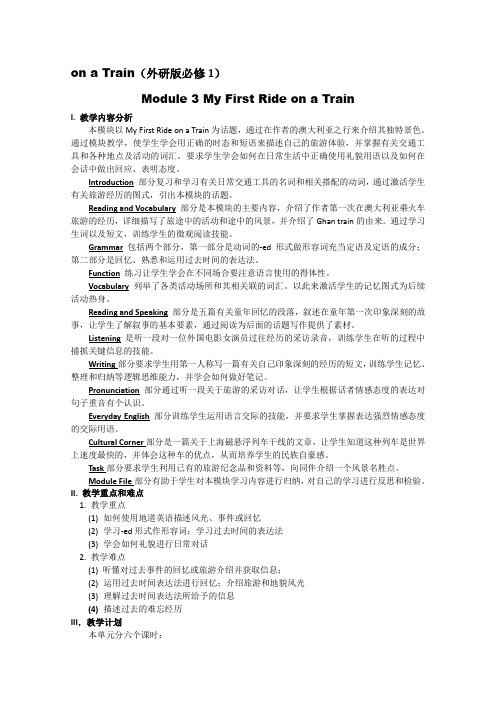
on a Train(外研版必修1)Module 3 My First Ride on a TrainI. 教学内容分析本模块以My First Ride on a Train为话题,通过在作者的澳大利亚之行来介绍其独特景色。
通过模块教学,使学生学会用正确的时态和短语来描述自己的旅游体验,并掌握有关交通工具和各种地点及活动的词汇。
要求学生学会如何在日常生活中正确使用礼貌用语以及如何在会话中做出回应、表明态度。
Introduction 部分复习和学习有关日常交通工具的名词和相关搭配的动词,通过激活学生有关旅游经历的图式,引出本模块的话题。
Reading and Vocabulary 部分是本模块的主要内容,介绍了作者第一次在澳大利亚乘火车旅游的经历,详细描写了旅途中的活动和途中的风景,并介绍了Ghan train的由来。
通过学习生词以及短文,训练学生的微观阅读技能。
Grammar 包括两个部分,第一部分是动词的-ed形式做形容词充当定语及定语的成分;第二部分是回忆、熟悉和运用过去时间的表达法。
Function 练习让学生学会在不同场合要注意语言使用的得体性。
Vocabulary列举了各类活动场所和其相关联的词汇。
以此来激活学生的记忆图式为后续活动热身。
Reading and Speaking 部分是五篇有关童年回忆的段落,叙述在童年第一次印象深刻的故事,让学生了解叙事的基本要素,通过阅读为后面的话题写作提供了素材。
Listening是听一段对一位外国电影女演员过往经历的采访录音,训练学生在听的过程中捕抓关键信息的技能。
Writing部分要求学生用第一人称写一篇有关自己印象深刻的经历的短文,训练学生记忆、整理和归纳等逻辑思维能力,并学会如何做好笔记。
Pronunciation部分通过听一段关于旅游的采访对话,让学生根据话者情感态度的表达对句子重音有个认识。
Everyday English 部分训练学生运用语言交际的技能,并要求学生掌握表达强烈情感态度的交际用语。
(完整word版)上海版牛津英语三年级上册教案m3Unit1Myschool

Module 3 Places and activitiesUnit 1 My schoolPeriod OneTeaching contents: Look and sayTeaching Aims:1. 知识目标:1) Using nouns to identify things2) Asking Wh- questions to find out about a specific thing 2. 能力目标:1) Open an interaction by eliciting a response2) Maintain an interaction by providing information to factual questions3. 情感目标:通过对学校的介绍激发学生对学校对班级的热爱Difficult and key points:1) New words: school, classroom, hall, toilet, office, playground, library2) New sentences:What’s this? It’s a /the ______. Is this a/the _________? Yes/No Teaching aids: tape, some pictures, word cardsModule 3 Places and activitiesUnit 1 My schoolPeriod TwoTeaching contents: Point, ask and answer Listen and actTeaching Aims:1. 知识目标:1) Asking yes/no questions to obtain simple responses2) Using imperatives to give instructions3) Asking Wh-questions to find out about a specific thing 2. 能力目标:1) Open an interaction by eliciting a response2) Maintain an interaction by providing information3) Maintain an interaction by using formulaic expressions to acknowledge, agree or disagree3. 情感目标:通过问答加深对学校的了解,通过学习课堂用语做到整齐划一Difficult and key points:1) Listen and respond2) Wh- questions: What’s this? It’s a /the _____.3) yes/no questions: Is this a / the ______?Yes, it is. No, it isn’t.Teaching aids: tape, some pictures and labelsTeaching procedure:Module 3 Places and activitiesUnit 1 My schoolPeriod ThreeTeaching contents: Play a matching game Learn the sounds Teaching Aims:1. 知识目标:1) Using plural forms of nouns to identify things2) Using numbers to show quantities3) Using formulaic expressions to express approval4) Pronounce correctly words in isolation with initial sounds / ei /& /æ /2. 能力目标:1) Discriminate between words with vowel sound ‘a’ in both open and closed syllable forms2) Use modeled phrases to communicate with other learners3. 情感目标:鼓励学生相互协作,懂得对他人的赞赏Difficult and key points:1) Numbers: from one to ten2) Plural forms of nouns: desks, chairs….3) Vowel sound: A a--/ ei /& /æ /Teaching aids: tape, some pictures cards and number cardsTeaching procedure:教学目标课程标准:根据教学目标,学生心趣为先,激励和培养孩子们学习英子们在听说玩演练中学会本课内容1.能听懂、会说几种家庭成员brother, sister, me及little和big2.能够在实际语言情境中运用is…能正确区分he和she并能熟3.培养学生热爱自己的家庭4.注重合作学习,培养学生教学重点及解决措施教学重点是本课时表示家庭成员的解决措施:1、通过创设情景,布置任务2、运用多媒体课件,创设出各种中逐步熟练掌握教学难点及解决措施教学难点是能够在实际语言中运用解决措施:1、通过创设情景,布置任务2、运用多媒体课件,创设出各“用”中逐步熟练掌握教学设计思路以课本教材为基础,综合整个单元启后,螺旋上升。
三年级下册英语教案-M3 U1 I like football 外研社(三起)
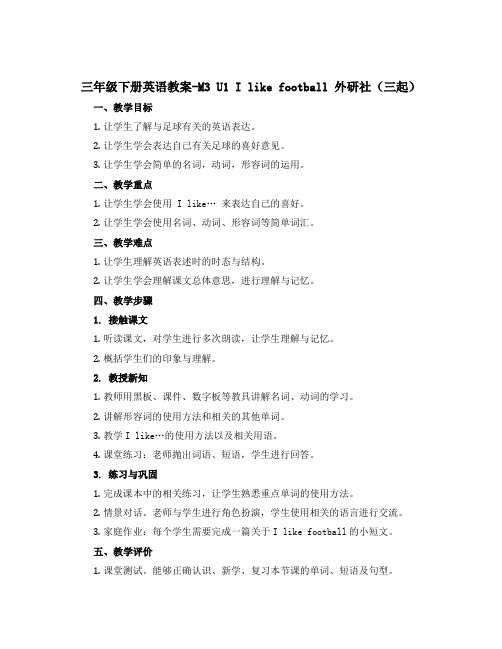
三年级下册英语教案-M3 U1 I like football 外研社(三起)一、教学目标1.让学生了解与足球有关的英语表达。
2.让学生学会表达自己有关足球的喜好意见。
3.让学生学会简单的名词,动词,形容词的运用。
二、教学重点1.让学生学会使用I like… 来表达自己的喜好。
2.让学生学会使用名词、动词、形容词等简单词汇。
三、教学难点1.让学生理解英语表述时的时态与结构。
2.让学生学会理解课文总体意思,进行理解与记忆。
四、教学步骤1. 接触课文1.听读课文,对学生进行多次朗读,让学生理解与记忆。
2.概括学生们的印象与理解。
2. 教授新知1.教师用黑板、课件、数字板等教具讲解名词、动词的学习。
2.讲解形容词的使用方法和相关的其他单词。
3.教学I like…的使用方法以及相关用语。
4.课堂练习:老师抛出词语、短语,学生进行回答。
3. 练习与巩固1.完成课本中的相关练习,让学生熟悉重点单词的使用方法。
2.情景对话。
老师与学生进行角色扮演,学生使用相关的语言进行交流。
3.家庭作业:每个学生需要完成一篇关于I like football的小短文。
五、教学评价1.课堂测试。
能够正确认识、新学、复习本节课的单词、短语及句型。
2.评分。
能够做到划重点、理解课文并完成相关的练习,以及对主要学习内容进行写作表述。
六、拓展活动1.骆驼杯足球比赛。
学生分组进行小组较量。
2.观看足球比赛,对比赛进行学习与讨论。
七、教学反思通过持续进行教学反思,帮助学生们更好的理解知识,并且在学生反馈中持续优化授课计划与方法,在确保学生能够完全理解新知识的前提下,持续推进下一步计划的实施。
外研版八年级英语上册教案 M3 Unit 3 教学设计
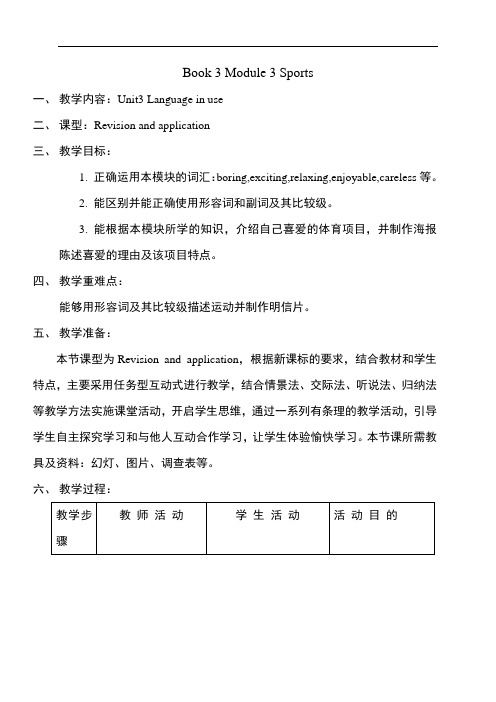
Book 3 Module 3 Sports一、教学内容:Unit3 Language in use二、课型:Revision and application三、教学目标:1. 正确运用本模块的词汇:boring,exciting,relaxing,enjoyable,careless等。
2. 能区别并能正确使用形容词和副词及其比较级。
3. 能根据本模块所学的知识,介绍自己喜爱的体育项目,并制作海报陈述喜爱的理由及该项目特点。
四、教学重难点:能够用形容词及其比较级描述运动并制作明信片。
五、教学准备:本节课型为Revision and application,根据新课标的要求,结合教材和学生特点,主要采用任务型互动式进行教学,结合情景法、交际法、听说法、归纳法等教学方法实施课堂活动,开启学生思维,通过一系列有条理的教学活动,引导学生自主探究学习和与他人互动合作学习,让学生体验愉快学习。
本节课所需教具及资料:幻灯、图片、调查表等。
六、教学过程:教师活动学生活动活动目的教学步骤1. Leadin g-in (7’)1.Show students ashort video aboutdifferent kinds ofball games.2.Have a free talkwith students.What’s yourfavourite sport?Why?1.The students watchthe video and learn thedifferent kinds of ballgames.2. Answer the questionslike this : My favouritesport is ...Because it’s...通过观看关于各种球类运动的视频,让学生从视觉上直观地了解各项球类运动的同时也活跃了课堂气氛,为进一步的学习做好铺垫。
通过与学生的自由交谈,复习了Unit1的知识点的同时也训练了学生的反应。
【教案】外研版小学英语一年级起点四年级下册M3教学设计
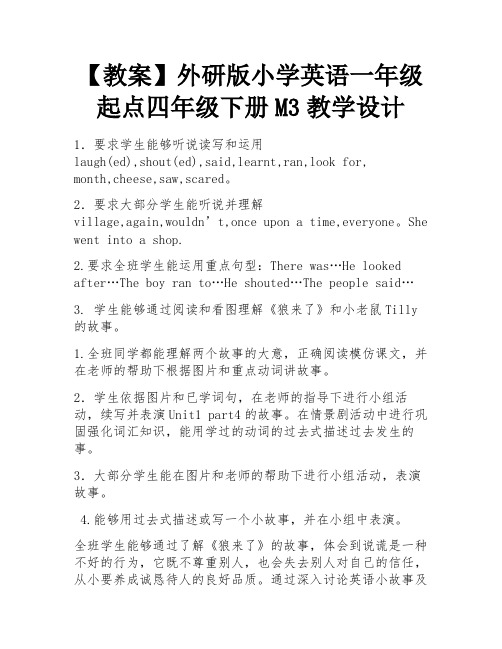
【教案】外研版小学英语一年级起点四年级下册M3教学设计
1.要求学生能够听说读写和运用
laugh(ed),shout(ed),said,learnt,ran,look for,
month,cheese,saw,scared。
2.要求大部分学生能听说并理解
village,again,wouldn’t,once upon a time,everyone。
She went into a shop.
2.要求全班学生能运用重点句型:There was…He looked after…The boy ran to…He shouted…The people said…
3. 学生能够通过阅读和看图理解《狼来了》和小老鼠Tilly
的故事。
1.全班同学都能理解两个故事的大意,正确阅读模仿课文,并在老师的帮助下根据图片和重点动词讲故事。
2.学生依据图片和已学词句,在老师的指导下进行小组活动,续写并表演Unit1 part4的故事。
在情景剧活动中进行巩固强化词汇知识,能用学过的动词的过去式描述过去发生的事。
3.大部分学生能在图片和老师的帮助下进行小组活动,表演故事。
4.能够用过去式描述或写一个小故事,并在小组中表演。
全班学生能够通过了解《狼来了》的故事,体会到说谎是一种不好的行为,它既不尊重别人,也会失去别人对自己的信任,从小要养成诚恳待人的良好品质。
通过深入讨论英语小故事及
对课后故事进行续写,激发学生的创造性思维,使学生在学习中体验到学习的成就感,树立学习自信心,培养提高学生学习英语的兴趣及良好的道德品质。
通过与同伴合作表演小故事,培养学生的合作精神。
外研版八年级英语下册教案 M3Journey to space U1
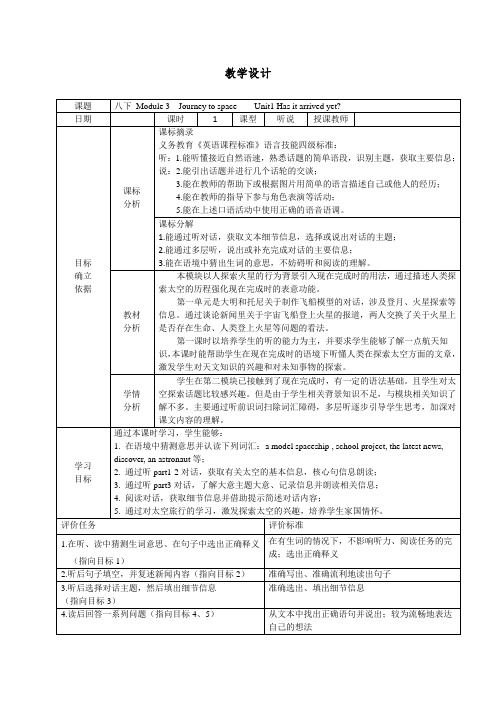
教学设计Step 3 Dialogue (SB A.3)3. Read and complete(1) Choose the correct answer:A model spaceship is a copy and usually smaller /bigger than a real one.School project means a subject with careful /careless study by students.The latest news means the oldest/newestinformation.Discover means the first /last person to find someone or something.An astronaut means a person whose job is travelling and working in thespaceship / company.(2) Answer the following questions according to the dialogue①Is there any life on Mars or other planets?②There aren’t any astronauts in the spaceship. Why?③Why do so many people want to be astronauts?④The astronauts will go to the Mars in the future. Do you agree? Why?⑤What can you do for Chinese space dream ?4. Go over the dialogue and try to retell the main content.Tony has just made a model spaceship for the school project. But Daminghasn’t started yet because he is not sure how to make it. Tony heard thelatest news that scientists have sent a spaceship to Mars. And it has landed on theMars after a journey of several months from the earth. Scientists have notdiscovered life on Mars yet. And no astronaut has ever been to Mars because it isvery far away.能在句子提供的语境中选出正确答案能根据文本信息并结合实际思考回答下列问题能根据提示,简要说出对话主要内容Step4 Summary Summary what we have learned.能根据思维导图归纳所学内容。
2023外研版英语八年级上册M1-M3知识点教学案

2023外研版英语八年级上册M1-M3知识点教学案教学目标本次课程将帮助学生掌握以下知识点:- M1 Unit 1: 学生们将学会如何询问和描述家庭成员的职业和描述自己的职业抱负- M2 Unit 2: 学生们将学会如何描述身体健康和表达感受- M3 Unit 3: 学生们将学会如何描述自己的家乡和邀请别人参拜旅游景点教学内容及计划本次课程将分为三个部分,分别掌握M1至M3三个单元的知识点。
Part 1. M1 Unit 11.1. 学生们将观看授课教师提供的视频,学会如何询问和描述家庭成员的职业。
- 学生将在视频中研究相关词汇和句型。
- 学生将进行朗读练和问答练。
1.2. 学生们将学会描述自己的职业抱负。
- 学生将通过写作、朗读和讨论的方式,描述自己未来理想的职业和成为该职业人员所需掌握的技能。
Part 2. M2 Unit 22.1. 学生们将学会描述身体健康和表达感受。
- 学生将研究相关词汇和句型。
- 学生将进行问答练、朗读和口头表达练。
2.2. 学生们将学会在日常生活中维护身体健康。
- 学生将通过讨论和展示不同的健康惯,学会如何维护身体健康。
Part 3. M3 Unit 33.1. 学生们将学会描述家乡和旅游景点。
- 学生将在视频中研究相关词汇和句型。
- 学生将进行问答练、朗读和口头表达练。
3.2. 学生们将学会邀请别人参观旅游景点。
- 学生将通过角色扮演和口头表达练,学会邀请别人参观旅游景点。
总结本次课程将通过视频教学和互动练习的方式,帮助学生掌握M1至M3三个单元的必要知识点,提高学生的英语口语和写作表达能力,并为学生未来学习打下良好基础。
外研版九年级英语上册教案 M3

外研版九年级上册M3 Heroes【课标摘录】义务教育《英语课程标准》语言技能五级标准:【教材分析】:主题意义:本模块以“英雄”为话题,介绍了体育、医疗、科技等领域的英雄人物。
通过学习,学生了解到这些英雄人物不屈不挠、意志坚定、刻苦勤奋的高贵品质,也能激发自己争做国家栋梁、为国争光的热情。
Unit 1的对话是大明和李老师在课堂上的谈话,主要由大明介绍了自己心目中的英雄—乒坛名将邓亚萍。
通过对话学习,学生可以了解到邓亚萍刻苦努力、锲而不舍的精神品质。
Unit 2是读写课,课文对白求恩的生平以及他对中国医疗事业的帮助做了介绍,他是中国最著名的医生之一,现在仍然被中国人和加拿大人所爱戴。
教师引导学生关注原因、结果、目的状语从句,帮助学生学会按时间顺序摘录英雄事迹中的重要信息。
【学情分析】:经过初中两年的英语学习积淀,学生有一定的词汇积累,能用英语表达自己对英雄的仰慕,但部分学生存在的问题是不会有逻辑地介绍自己仰慕的英雄。
学生对这个话题也非常感兴趣,所以学习兴趣浓厚。
学生对原因、结果状语从句有所接触,但因母语的“负迁移”影响,学生对because,so两个连词的使用会出现一些困难;在听和阅读的过程中,克服生词障碍、根据上下文推断词义的能力还有待提高。
在读和说的过程中,有感情地流利朗读能力和语音、语调准确自然的表达能力还有待提高。
【模块目标】:听:听辨对话中的人物及其关系,明确对话场所和话题说:谈论个人心目中的英雄人物及其事迹读:能够通过阅读了解英雄人物的生平,并对重要事件按时间顺序排序写:能够根据时间轴提示写一篇文章介绍袁隆平运用:能够写一篇文章,向他人介绍自己心目中的英雄基于课程标准的“教学评一体化”设计课时备课卡。
人教版高中英语必修 第三册Unit 3 教案

M3 U3 Reading and Thinking教学设计&学案一、文本解读该阅读文本是一则旅行日记。
在日记中,中国学生Li Lan记录了自己的加州之行,并主要介绍了在旧金山一天的行程和所见所闻所感,从最初对地震后重建的旧金山的建筑产生兴趣到探索这个城市,慢慢体会到多元文化对它的不同方面的影响。
旅行日记与日记相似,首行是日期,正文即主体部分,常以第一人称讲述在旅行地参观的景点、参与的活动和旅行的感受。
本篇旅行日记结构清晰,作者按照时间顺序叙述了自己再旧金山一天的行程。
第一段描述了作者对旧金山的第一印象。
第二、三、四分别叙述了作者上午、下午、傍晚在旧金山的所做所见所闻所感。
第五段叙述了第二天的行程安排。
贯穿该旅行日记的主线是旧金山的多元文化,作者在一天的旅行过程中体验和体会到了多元文化在这个城市的各个方面的体现。
在阅读策略方面,学生通过寻读快速浏览文本,找到一些特殊信息,如时间、地点等;通过细读文本,提取、梳理和加工作者活动、感想、印象等,并用结构图呈现出来(Classify and organize information by drawing a diagram)。
二、课时目标通过本课时的学习,学生能够:1. 运用寻读策略,寻找、提取旅行时间、地点、图片,分析语篇类型。
2. 运用提取、梳理、加工、归纳等策略,寻找和梳理旅行活动,归纳和推断作者旅行的感想,并用结构图加以呈现,积累相关主题语言。
3.讨论旧金山多元文化的特点和成因。
4. 讨论多元文化对生活的影响。
三、教学重难点引导学生理解旧金山的多元文化特征和影响;指导学生使用结构图分类和整理文本信息,从而把握文章的结构和作者的写作逻辑。
四、设计思路教师首先以一则San Francisco的介绍视频为导入,要求学生找出视频中涉及的地点,随后分享want to know,激发学生学习兴趣,激活学生已有的背景知识和主题词汇;讨论diverse culture的意思,引出单元主题;引导学生通过寻读定位旅行地点、时间、图片,分析旅行日记的语篇特点;然后引导学生通过细读、提取、梳理、加工信息等阅读策略,持续默读,聚焦文本主要内容,分组完成作者旅行见闻和感想的结构图;然后引导学生再次阅读文本,概括旧金山多元文化的特点,推断、归纳多元文化对人们生活的影响;最后引导学生以V-log的形式介绍这个多元文化的为特点的城市,整合输出语言。
M3 U1 Where did you go教案(公开课用)

Module3 Unit1 Where did you go?外研版·五年级英语上册一.教学目标1.能够听,说,读写下列单词:how, took(take),river,hour,place2.能够熟练使用句型“Where did you go?”“How did you go there?”和“What did you do?”来谈论旅游活动。
3.能够询问和讲述自己或他人过去发生的事情。
4.增加跨国文化交流意识,培养热爱祖国的民族自豪感。
二.教学重难点1.能够熟练运用一般过去时态。
2.能够理解掌握特殊疑问句。
3.能够使用英语交流旅游经历。
4.掌握不规则动词过去式do-did, eat-ate,buy-bought三.教学过程Step1:Warm-up1.教师出示PPT3,学唱歌曲。
T:Let’s listen and sing it.2.教师出示PPT4,引导学生谈论自己昨天的活动。
T:Yesterday was Sunday.I went to the park.Where did you go?What did you do yesterday?S:Step2:Presentation1.教师出示PPT5-9,让学生打开课本第14页。
学生先自主阅读,然后小组讨论,互助学习。
T:Amy and her friends had a lovely time at the weekend.1.What did they do there?Please read it by yourselves.Then, you can talk it with your friends.T:Time’sup.What did they do there?S1:Theyvisi ted lots of places.(引导学生说出places)T:Good job!Read after me “place,place”!S:Place,place!教师板书新单词在黑板上。
外研九上M3 Heroes U3 教案
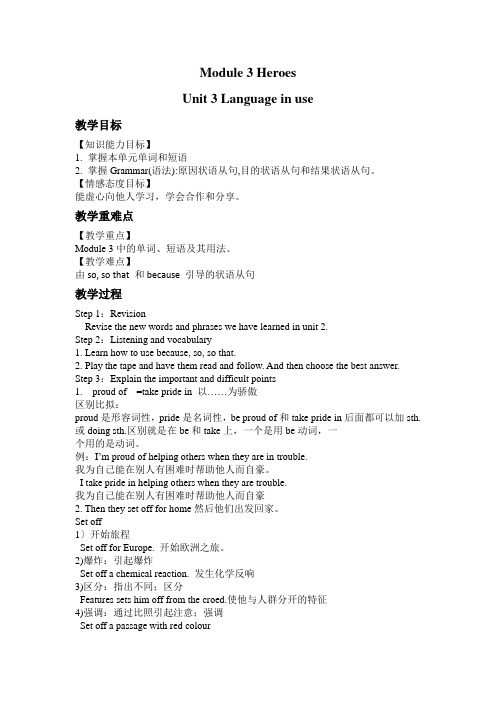
Module 3 HeroesUnit 3 Language in use教学目标【知识能力目标】1. 掌握本单元单词和短语2. 掌握Grammar(语法):原因状语从句,目的状语从句和结果状语从句。
【情感态度目标】能虚心向他人学习,学会合作和分享。
教学重难点【教学重点】Module 3中的单词、短语及其用法。
【教学难点】由so, so that 和because 引导的状语从句教学过程Step 1:RevisionRevise the new words and phrases we have learned in unit 2.Step 2:Listening and vocabulary1. Learn how to use because, so, so that.2. Play the tape and have them read and follow. And then choose the best answer. Step 3:Explain the important and difficult points1. proud of =take pride in 以……为骄傲区别比拟:proud是形容词性,pride是名词性,be proud of和take pride in后面都可以加sth. 或doing sth.区别就是在be和take上,一个是用be动词,一个用的是动词。
例:I’m proud of helping others when they are in trouble.我为自己能在别人有困难时帮助他人而自豪。
I take pride in helping others when they are trouble.我为自己能在别人有困难时帮助他人而自豪2. Then they set off for home然后他们出发回家。
Set off1〕开始旅程Set off for Europe. 开始欧洲之旅。
外研版八年级英语下册教案 M3 Journey to space U2 (2)

教学设计Step 1 Warming up 1.Watch a video about space science fiction films.(Q: How do you feel when you watch them ?)2.Lightning round(快问快答): 航天知识知多少A.Do you know who is the first astronaut in the world?China’s first astronaut?B.Which country have sent spaceships to the moon?C.Which planet have humans landed in space?D.Which planet has China sent Tianwen 1 detector to?E.What are you interested in the space?学生能积极活跃的回答问题即可。
允许说错,主要摸清学生对航天知识了解多少。
Step 2 Presentation Learn new words (图片+句子)We need to _________ (communicate)withothers in the world.None of us like to be alone.We celebrate World __________ Day on June5th every year.We need to protect________ because we onlyhave one Earth.The sun and its planets are called the_________.学生能说出与图片信息相关的词汇Step 3 Fast reading 1.Match the key words with each part.Part 1 (Para 1) Scientists’questionsPart 2 (Para2&3) Space exploration(探索)Part 3 (Para 4) Scientists’discoveryPart 4 (Para 5) The solar system and the universe2.Read the passage and choose the best title.(√)()Anyone out there?()Life on the earth()The sun and other stars()The stars at night能说出依据,正确连线能正确选出标题Step 4 Carefulreading 1.Read Para 1 carefully and answer the questionHow many years has there been life on the earth?2.Read the para2-3(1)put them in order: small-largegalaxy planet solar system star universe(2)complete the sentences.①The Earth is a _______ and it goes around the Sun. There正确回答问题能正确填词We have learned1.How to choose the best title2.The relationship among stars in the sky;。
- 1、下载文档前请自行甄别文档内容的完整性,平台不提供额外的编辑、内容补充、找答案等附加服务。
- 2、"仅部分预览"的文档,不可在线预览部分如存在完整性等问题,可反馈申请退款(可完整预览的文档不适用该条件!)。
- 3、如文档侵犯您的权益,请联系客服反馈,我们会尽快为您处理(人工客服工作时间:9:00-18:30)。
M3U1 Where did you go?目标知识与能力能听、说、认读本课的重点单词:the British Museum, theLondonEye,weekend,place,how,best,took,trip,along,river,hour,twenty,minute;能正确使用动词过去式;能利用What did you do? Where did you go? 询问别人过去做的事情。
过程与方法通过活动体验,在交流中学会谈论上周末从事的活动,谈论不久前发生的事情,发展综合语言运用能力。
提高学生跨文化交际意识。
情感与态度培养学生学习的兴趣,鼓励学生积极合作,引导学生了解西方的名胜古迹。
重点使学生能听说,认读单词the British Museum, the London Eye,weekend,place,how,best,took,trip,along,river,hour,twenty,minute;能准确理解并熟练运用What did you do at the weekend? Where did you go? Where/How/When/What did…?难点掌握本课的新单词及利用动词过去式的变化进行描述。
教法任务型教学法学法合作交流法教学准备课件CD-ROM预习设计预习单词课文,各听读10遍教学过程二次备课Step1.Warming-up1. Greetings T: Good morning, boys and girls.Ss: Good morning, Ms Yang.T: How are you?Ss: Fine, thanks.2. Sing a song: 《Where did you go?》3.复习动词的过去式:教师以连线的方式考察学生对动词过去式的掌握情况。
go send like meet visit sent liked met visited met (设计意图:利用歌谣开始本课教学,可以创设轻松的学习氛围,消除学生的紧张情绪,由歌曲《Where did you go?》引出本课的重点句型,激发学生的兴趣。
复习动词的过去式,为后面的教学环节做好铺垫。
) Step2Presentation1、教学新词汇(1)T : Amy’s weekend is very nice. She visited lots of places. Let’s see the wonderful places. 课件呈现图片,但是学生可以选择任何一个图片的序号猜猜地点。
通过猜一猜让学生增加兴趣。
T: Now please guess the places, you can choose the number and guess. S1: Number 1.T: What’s this?S1: It’s the British Museum.以同样的方式呈现the London Eye, Big Ben。
教师领读几遍。
然后请学生读课文句子:We went to the British Museum. And we visited Big Ben and the London Eye.呈现学习新词: TheBritishMuseum,theLondonEye,weekend,place,how,best,took,trip,alo ng,river,hour,twenty,minute2 . Practice1).当学生已经明白单词含义后,让学生开始认读单词:利用课件快速闪现单词,要求学生快速整体认读。
学生分组认读单词。
然后请一个学生抽取单词,另一个学生猜测,如果不对,下面的学生大声朗读进行纠错。
如果说对了,就说.单词、图片配对游戏(请六个学生分别说上面的句子,下面的学生根据句子中所含的新单词进行图片和单词的配对。
比一比谁的动作快作快)4). 说说自己的周末T: Just now we talk about Amy’s weekend. Now let’s talk about ourweekend. Who wants to show us your weekend? 请几个学生上台表演周末所做的事,其他同学猜一猜顺序如下:(1)Ss: What did you do at the weekend? (2)S1进行表演。
(3)其他学生说出表演的内容。
Eg: Liyun went to the supermarket at the weekend. (示范表演为学生提供一个可操作的模式,以任务型的活动方式,通过合作学习,并予以评价知道,给学生提供平等的说英语的机会,鼓励学生在竞赛中学,这样既创造了轻松愉快、自然和谐的课堂气氛,又促进了交流。
)3.presentingthenewtext:T:Lingling had a happy weekend. Where did she go? Let’s listen and answer my questions.(1)Listen to the text and answer questions: What did you do at the weekend? Where did you go? What is the London Eye? How did you go to these places?(2)Listen and repeat.(3)Group work:小组合作,回答问题。
(设计意图:通过“任务型”听录音,教师领读,纠正学生发音,教给学生正确的发音,让他们习惯标准发音,进而有意识的模仿,形成正确的口语。
)Step3 practice(1)教师引导学生回答“What do you usually do at the weekend?”让学生将平时周末所做的活动罗列出来。
点击课件,出示日历。
指着上个周末问学生“What did you do at the weekend?”鼓励学生用学过的过去式回答问题。
(2)教师准备一些风景名胜的图片,贴在教室的黑板上。
如“the Great Wall, Mt Tai, the Summer Palace.”请两个学生上台活动,一个学生问“Where did you go?”另一学生站在不同图片前回答“I went to the …”(设计意图:通过生动活泼的活动,呈现本课重点句型。
该活动能让学生动一动,学生在动的过程中既活跃了思维,又操练了新句型。
)Step4 Homework1、介绍你与家人的上周末生活。
2、向你的好友介绍你的旅游经历,讲述你曾参观的名胜古迹。
(自选一个内容,并写下来。
)【板书设计】Unit I Where did you go?单词;the British Museum, the London Eye, museum, trip,along, river,twenty minutes句子;What did you do at the weekend?Where did you go?M3U2 Daming took a photo of his father目标知识与能力使学生能听说,认读单of,hour,wall,arrive,mountain,with,plant能准确理解并熟练运用What did you do at the weekend?Where did you do? Where/How/When/What did…?过程与方法通过活动体验,在交流中学会谈论上周末从事的活动,谈论不久前发生的事情,发展综合语言运用能力。
提高学生跨文化交际意识。
情感与态度培养学生学习的兴趣,鼓励学生积极合作,引导学生了解西方的名胜古迹。
重点使学生能听说,认读单词postcard, hour能准确理解并熟练运用What did you do at the weekend? Where did you go? Where/How/When/What did…?难点①在真实情景中灵活运用新知识描述过去发生的事情。
②不规则动词的过去式。
教法情景教学法学法合作交流法教学准备课件CD-ROM预习设计预习单词课文,各听读10遍教学过程二次备课Ⅰ. Warm-up【热身复习】新1、Greeting2、Game:学生表演自己上周末的活动,全班通过猜其活动来复习一般过去时的表达。
T:What did she/he do last weekend?S: She watched TV.3、Group word——What did you do last weekend?4、学唱歌曲“The London Eye”并学习语音部分Ⅱ.Pre-task【任务呈现——我们的足迹】1、导入:教师准备一些名胜古迹的图片与旅游时所照的照片,通过描述让学生猜是哪个地方。
如:It’s very long and old. It’s in Beijing. Where is it? 学生答:The Great Wall.2、Free task——谈论旅游经历师:“There are many places of interest in China, Where did you go?”生:I went to Huang guo shu Falls, It’s big and wonderful.同桌互相介绍曾去过的名胜古迹或城市。
3、[任务呈现]师:“Did you have a good time on your trip?”Can you share your experiences with us? Today, Let’s write a traveling d iary.Ⅲ.While-task【任务实施】1、视听结合,有声有色师:Daming and his father had a good weekend. Where did they go?Let’s go and see.播放课文,进行听法指导,请学生根据课文完成课文活动2的问题。
2、教师分段播放录音,请学生回答问题,解读课文难点。
Q1: Who went to the Great wall?A: Daming and his father.Q2: When did they go?A: They went there at ten o’clock in the morning.Q3: How did they go?A: They went there by bus.Q4: What did they do? HtA: They took photos of the mountains.Q5: What did Daming do?He took a photo of his father.3、教师再次播放录音,请学生跟读,教师给予适当的指导。
